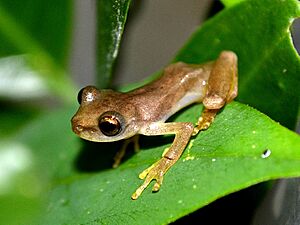Exerodonta sumichrasti facts for kids
Quick facts for kids Exerodonta sumichrasti |
|
|---|---|
 |
|
| Conservation status | |
| Scientific classification | |
| Synonyms | |
|
Hylella platycephala Cope, 1879 |
The Sumichrast's treefrog (scientific name: Exerodonta sumichrasti) is a type of frog that belongs to the Hylidae family, also known as the treefrog family. This special frog lives only in Mexico. You can find it on the Pacific side of southern Mexico, in states like Guerrero, Oaxaca, and Chiapas. It also lives in the high lands of Chiapas.
What It Looks Like
Adult male Sumichrast's treefrogs are about 23 to 28 millimeters long. That's about the size of a small paperclip! Female frogs are a bit bigger, measuring 29 to 33 millimeters. This measurement is taken from their snout (nose) to their vent (bottom).
This frog has a wide, flat head. Its snout looks long and pointed when you look at it from above. It has a clear eardrum, called a tympanum, but sometimes skin covers part of it.
Its arms are short and strong. The fingers are also short and thick, with fairly large sticky pads at the ends. Their fingers are partly webbed, like a duck's foot. The legs are also quite short and strong. Their toes are moderately long and thin, with sticky pads that are a little smaller than the finger pads. Their toes are about three-quarters webbed.
The color of their back can change a lot. Some frogs are a light green or grayish-green. Others might be yellowish-tan or light brown. Some even have tiny, darker spots on their skin.
Where It Lives and How We Protect It
The Sumichrast's treefrog lives in natural areas called habitats. These are usually sub-humid oak and pine forests. You can find them at elevations from 200 to 2000 meters above sea level.
During the dry season, these frogs often hide in bromeliads. Bromeliads are plants that grow on trees. They collect water in their leaves, making a perfect little home for the frogs. When it's time for them to have babies, they go to streams to lay their eggs.
Even though this frog is common, its home is slowly disappearing. This is called habitat loss. People are working to protect these forests so the Sumichrast's treefrog can continue to thrive.


